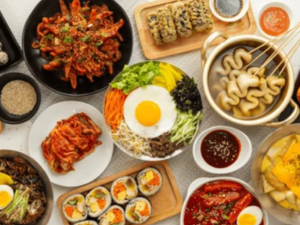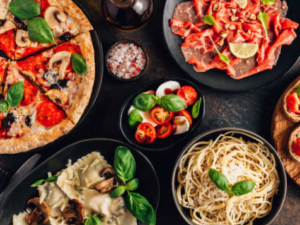Description
Introduction to Indian Cuisine
Indian cuisine is a vibrant and diverse tapestry, reflecting the subcontinent’s rich historical roots and cultural significance. With a history that spans thousands of years, Indian cooking has evolved through the influence of various civilizations, religions, and trade interactions. Each region across India boasts its own unique culinary traditions, characterized by distinct flavors, ingredients, and cooking techniques that are influenced by geography, climate, and local customs.
The geographical diversity of India plays a crucial role in shaping its culinary profile. From the coastal regions where seafood is prominent to the arid deserts where spices thrive, the ingredients available vary widely. This leads to a vast spectrum of regional dishes, ranging from the fragrant biryanis of the north to the spicy curries of the south. Furthermore, the interplay of different cultures, including Persian, Mughal, and British influences, has enriched Indian cuisine with an eclectic mix of tastes and cooking methods.
At the heart of Indian cooking is the use of spices, which are not just flavor enhancers but also carry health benefits. The careful selection and blending of spices like cumin, coriander, turmeric, and cardamom create the intricate flavors that are a hallmark of Indian food. Each region has its own spice mix, often handcrafted and passed down through generations, reflecting local resources and culinary traditions. This emphasis on spices not only contributes to the taste but also elevates the art of cooking to a profound cultural expression.
Understanding Indian cuisine invites one to explore its many layers, from traditional recipes to modern interpretations, making it a captivating subject for both culinary enthusiasts and cultural historians alike. The fusion of flavors and techniques continues to evolve, yet the essence of Indian cooking remains deeply tied to its roots.
Regional Variations in Indian Cuisine
Indian cuisine is a reflection of the country’s diverse geography, culture, and traditions, resulting in a rich tapestry of regional culinary practices. Each region of India boasts its own distinct flavors, ingredients, and cooking techniques, shaped by its history and the local environment. Understanding these regional variations provides insights into the complexity of Indian cooking.
The Punjab region is renowned for its hearty, robust dishes that often feature cream and butter. Dishes like butter chicken and sarson da saag paired with makki di roti are staples. These meals frequently harness the agricultural bounty of the plains, emphasizing wheat and dairy, which are integral components of Punjabi cuisine.
Contrasting with Punjab, South Indian cuisine presents a lighter fare, often featuring rice as the main staple. This region is known for its idlis and dosas, which are made from fermented rice and lentil batter. The use of coconut, curry leaves, and a variety of spices such as mustard seeds contributes to the distinctive flavors of South Indian dishes.
In the eastern part of India, specifically Bengal, cuisine is characterized by its emphasis on fish and rice. Bengali dishes often include an array of spices and ingredients like mustard oil and yogurt. Signature dishes such as macher jhol (fish curry) highlight the region’s affinity for fresh seafood and its ability to balance flavors harmoniously.
Moving westward, Gujarati cuisine is recognized for its vegetarian offerings and unique sweet-sour flavor profile. The usage of lentils, beans, and seasonal vegetables in dishes such as dhal and dhokla showcases the region’s agricultural practices, transforming simple ingredients into flavorful meals.
Each of these regional cuisines represents a unique story of its people, ingredients, and traditions. By exploring these culinary traditions, one gains a deeper appreciation for the complex and varied nature of Indian cuisine.
Key Ingredients and Spices in Indian Cooking
Indian cuisine is renowned for its complex flavors and vibrant dishes, which are primarily made possible by the use of a rich array of ingredients and spices. At the heart of Indian cooking are various spices that not only enhance flavor but also contribute to health benefits. Turmeric, with its distinctive yellow color, is celebrated for its anti-inflammatory properties and is a staple in many Indian recipes. It adds an earthy taste and is often used in curries and rice dishes.
Cumin is another vital spice, known for its warm, nutty flavor. It is commonly used both in its whole seed form and as ground powder. Cumin aids digestion and adds depth to a wide variety of dishes, from spice blends to lentil soups. Similarly, coriander seeds and cilantro are extensively used in Indian cooking. The seeds offer a citrusy and slightly sweet flavor when ground while fresh cilantro leaves provide a vibrant garnish, enriching dishes with their fresh, aromatic qualities.
Garam masala, a blend of various ground spices, is essential in imparting the characteristic warmth and depth to many Indian meals. While variations exist based on regional preferences, common components include cinnamon, cloves, and cardamom. This spice mix is often added towards the end of cooking to preserve its aromatic properties.
In addition to spices, staple ingredients like rice, lentils, and various forms of bread, such as naan and roti, form the foundation of many Indian meals. Rice typically serves as a base for curries, while lentils are vital sources of protein, particularly in vegetarian diets. A wide variety of vegetables, including potatoes, tomatoes, and spinach, are also prevalent, allowing for diversity in meals. The use of these ingredients and spices not only characterizes Indian cuisine but also showcases its rich cultural heritage. Each component reflects the regional variations and historical influences that shape this flavorful culinary landscape.
Culinary Techniques and Cooking Methods
Indian cuisine is renowned for its complexity and depth of flavor, partly attributable to the diverse culinary techniques employed throughout the region. One of the most significant methods is tempering, often referred to as ‘tadka’. This technique involves heating oil and adding spices to it, which enhances their aromatic properties and releases essential oils. Typically, ingredients such as mustard seeds, cumin seeds, and dried red chilies are used, producing an explosion of flavors that elevates the entire dish. Tempering is widely utilized in curries, lentil dishes, and even rice preparations, marking it as a fundamental technique in Indian cooking.
Another vital method is slow cooking, known as ‘dum’. This technique involves sealing ingredients in a pot, allowing them to cook at low temperatures for an extended period. Dum cooking infuses the dish with flavors and aromas, as the steam condenses and circulates within the sealed pot. This method is especially popular for biryanis and certain meat preparations, lending rich textures and deep flavors that reflect the traditions of Indian cuisine.
Marinating is also essential in Indian culinary practices, as it allows spices and flavors to penetrate the food, especially meats and vegetables. Typical marinades may include yogurt, spices, and herbs, which tenderize the ingredient while imparting distinct flavors. This technique can be traced back to ancient practices and continues to play a significant role in preparing dishes such as kebabs and tandoori items.
The use of traditional cooking utensils enhances these methods significantly. Tandoors, or clay ovens, are crucial for baking breads like naan and cooking marinated meats at high temperatures, resulting in a unique charred flavor. Similarly, clay pots are ideal for slow-cooked dishes, as they retain heat evenly and provide a distinctive earthy taste. Each technique and utensil in Indian cooking reflects the region’s rich culinary heritage and emphasis on flavor, texture, and nutrition.





